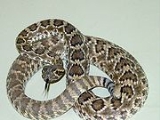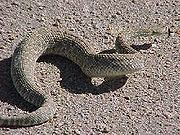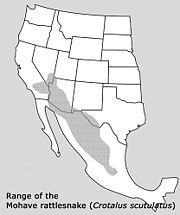
Crotalus scutulatus
Encyclopedia
- Common names: Mohave rattlesnake, MojaveMojave DesertThe Mojave Desert occupies a significant portion of southeastern California and smaller parts of central California, southern Nevada, southwestern Utah and northwestern Arizona, in the United States...
green, more.
Crotalus scutulatus is a venomous
Venomous snake
"Poisonous snake" redirects here. For true poisonous snakes, see Rhabdophis.Venomous snakes are snakes which have venom glands and specialized teeth for the injection of venom...
pitviper
Crotalinae
The Crotalinae, commonly known as "pit vipers" or crotaline snakes, are a subfamily of venomous vipers found in Asia and the Americas. They are distinguished by the presence of a heat-sensing pit organ located between the eye and the nostril on either side of the head...
species
Species
In biology, a species is one of the basic units of biological classification and a taxonomic rank. A species is often defined as a group of organisms capable of interbreeding and producing fertile offspring. While in many cases this definition is adequate, more precise or differing measures are...
found in the deserts of the southwestern United States
Southwestern United States
The Southwestern United States is a region defined in different ways by different sources. Broad definitions include nearly a quarter of the United States, including Arizona, California, Colorado, Nevada, New Mexico, Oklahoma, Texas and Utah...
and central Mexico
Mexico
The United Mexican States , commonly known as Mexico , is a federal constitutional republic in North America. It is bordered on the north by the United States; on the south and west by the Pacific Ocean; on the southeast by Guatemala, Belize, and the Caribbean Sea; and on the east by the Gulf of...
. It is perhaps best known for its potent neurotoxic venom. Two subspecies
Subspecies
Subspecies in biological classification, is either a taxonomic rank subordinate to species, ora taxonomic unit in that rank . A subspecies cannot be recognized in isolation: a species will either be recognized as having no subspecies at all or two or more, never just one...
are recognized, including the nominate subspecies described here.
Description

The color varies from shades of brown to pale green depending on the surroundings. The green hue found among Mojave rattlesnakes has led to them being known as "Mojave greens" in some areas. Like C. atrox
Crotalus atrox
Crotalus atrox, the "western diamondback rattlesnake", is a venomous rattlesnake species found in the United States and Mexico. It is likely responsible for the majority of snakebite fatalities in northern Mexico and the second greatest number in the USA after C. adamanteus. No subspecies are...
(the Western Diamondback rattlesnake), which it closely resembles, the C. scutulatus has a dark diamond pattern along its back. With C. scutulatus the white bands on the tail tend to be wider than the black, while the band width is usually more equal in C. atrox. Additionally, C. scutulatus has enlarged scales on top of the head between the supraoculars and the light post-ocular stripe passes behind the corner of the mouth. In C. atrox, the crown is covered in small scales and the light post-ocular stripe intersects the mouth.
Common names
Mojave rattlesnake, Mojave green, Mohave rattlesnake, Mojave diamond rattlesnake, Mojave rattler, scutulated rattlesnake. In MexicoMexico
The United Mexican States , commonly known as Mexico , is a federal constitutional republic in North America. It is bordered on the north by the United States; on the south and west by the Pacific Ocean; on the southeast by Guatemala, Belize, and the Caribbean Sea; and on the east by the Gulf of...
, this species is known as Chiauhcóatl (Nahuatl), or víbora de cascabel (rattlesnake in Spanish
Spanish language
Spanish , also known as Castilian , is a Romance language in the Ibero-Romance group that evolved from several languages and dialects in central-northern Iberia around the 9th century and gradually spread with the expansion of the Kingdom of Castile into central and southern Iberia during the...
). C. s. scutulatus has also been referred to as the northern Mojave rattlesnake.
Campbell and Lamar (2004) support the English name "Mohave rattlesnake", but do so with some reluctance because so little of the snake's range lies within the Mojave Desert
Mojave Desert
The Mojave Desert occupies a significant portion of southeastern California and smaller parts of central California, southern Nevada, southwestern Utah and northwestern Arizona, in the United States...
. They don't support the spelling "Mojave", because the name "Mohave" derives from the Native American term hamakhava.
Geographic range

California
California is a state located on the West Coast of the United States. It is by far the most populous U.S. state, and the third-largest by land area...
, southern Nevada
Nevada
Nevada is a state in the western, mountain west, and southwestern regions of the United States. With an area of and a population of about 2.7 million, it is the 7th-largest and 35th-most populous state. Over two-thirds of Nevada's people live in the Las Vegas metropolitan area, which contains its...
, extreme southwestern Utah
Utah
Utah is a state in the Western United States. It was the 45th state to join the Union, on January 4, 1896. Approximately 80% of Utah's 2,763,885 people live along the Wasatch Front, centering on Salt Lake City. This leaves vast expanses of the state nearly uninhabited, making the population the...
, most of Arizona
Arizona
Arizona ; is a state located in the southwestern region of the United States. It is also part of the western United States and the mountain west. The capital and largest city is Phoenix...
, southern New Mexico
New Mexico
New Mexico is a state located in the southwest and western regions of the United States. New Mexico is also usually considered one of the Mountain States. With a population density of 16 per square mile, New Mexico is the sixth-most sparsely inhabited U.S...
and western Texas
Texas
Texas is the second largest U.S. state by both area and population, and the largest state by area in the contiguous United States.The name, based on the Caddo word "Tejas" meaning "friends" or "allies", was applied by the Spanish to the Caddo themselves and to the region of their settlement in...
. Also ranges southward through much of Mexico
Mexico
The United Mexican States , commonly known as Mexico , is a federal constitutional republic in North America. It is bordered on the north by the United States; on the south and west by the Pacific Ocean; on the southeast by Guatemala, Belize, and the Caribbean Sea; and on the east by the Gulf of...
to southern Puebla
Puebla
Puebla officially Estado Libre y Soberano de Puebla is one of the 31 states which, with the Federal District, comprise the 32 Federal Entities of Mexico. It is divided in 217 municipalities and its capital city is Puebla....
. It is found in deserts and other areas with xeric vegetation from near sea level to about 2500 m altitude. No type locality is given. Smith and Taylor (1950) proposed "Wickenburg, Maricopa county, Arizona" (USA), while Schmidt (1953) listed the type locality as "Mojave Desert, California" (USA). See map at right.
Habitat
Primarily a snake of high desert or lower mountain slopes, they are often found near scrub brush such as mesquiteMesquite
Mesquite is a leguminous plant of the Prosopis genus found in northern Mexico through the Sonoran Desert and Chihuahuan Deserts, and up into the Southwestern United States as far north as southern Kansas, west to the Colorado Desert in California,and east to the eastern fifth of Texas, where...
and creosote
Creosote bush
Larrea tridentata is known as Creosote bush as a plant, chaparral as a medicinal herb, and as "gobernadora" in Mexico, Spanish for "governess," due to its ability for inhibiting the growth of nearby plants to have more water. In Sonora, it is more commonly called "hediondilla." It is a flowering...
, but may also reside in lowland areas of sparse vegetation, among cacti
Cacti
-See also:* RRDtool The underlying software upon which Cacti is built* MRTG The original Multi Router Traffic Grapher from which RRDtool was "extracted".* Munin -External links:******...
, Joshua tree forests, or grassy plains. They tend to avoid densely vegetated and rocky areas, preferring open arid habitats.
Conservation status
This species is classified as Least Concern (LC) on the IUCNWorld Conservation Union
The International Union for Conservation of Nature and Natural Resources is an international organization dedicated to finding "pragmatic solutions to our most pressing environment and development challenges." The organization publishes the IUCN Red List, compiling information from a network of...
Red List of Threatened Species
IUCN Red List
The IUCN Red List of Threatened Species , founded in 1963, is the world's most comprehensive inventory of the global conservation status of biological species. The International Union for Conservation of Nature is the world's main authority on the conservation status of species...
(v3.1, 2001). Species are listed as such due to their wide distribution, presumed large population, or because it is unlikely to be declining fast enough to qualify for listing in a more threatened category. The population trend is stable. Year assessed: 2007.
Behavior
Most active from April to September, and Brumate alone or in small groups during the winter. Ambush predators, they eat mostly small rodents and lizards. Females bear live youngOvoviviparity
Ovoviviparity, ovovivipary, or ovivipary, is a mode of reproduction in animals in which embryos develop inside eggs that are retained within the mother's body until they are ready to hatch...
, from two to seventeen (average about eight), from July through September. Although they have a reputation for being aggressive towards people, such behavior is not described in the scientific literature. Like other rattlesnakes they will defend themselves vigorously when disturbed.
Venom
Rattlesnake venoms are complex cocktails of enzymes and other proteins that vary greatly in composition and effects, not only between species, but also between geographic populations within the same species. C. scutulatus is widely regarded as producing one of the most toxic snake venoms in the New World, based on studies in laboratory mice. Their potent venom is the result of a presynapticChemical synapse
Chemical synapses are specialized junctions through which neurons signal to each other and to non-neuronal cells such as those in muscles or glands. Chemical synapses allow neurons to form circuits within the central nervous system. They are crucial to the biological computations that underlie...
neurotoxin
Neurotoxin
A neurotoxin is a toxin that acts specifically on nerve cells , usually by interacting with membrane proteins such as ion channels. Some sources are more general, and define the effect of neurotoxins as occurring at nerve tissue...
composed of two distinct peptide
Peptide
Peptides are short polymers of amino acid monomers linked by peptide bonds. They are distinguished from proteins on the basis of size, typically containing less than 50 monomer units. The shortest peptides are dipeptides, consisting of two amino acids joined by a single peptide bond...
subunits. The basic subunit (a phospholipase A2
Phospholipase
A phospholipase is an enzyme that hydrolyzes phospholipids into fatty acids and other lipophilic substances. There are four major classes, termed A, B, C and D, distinguished by the type of reaction which they catalyze:*Phospholipase A...
) is mildly toxic and apparently rather common in North American rattlesnake venoms. The less common acidic subunit is not toxic by itself but, in combination with the basic subunit, produces the potent neurotoxin called “Mojave toxin.” Nearly identical neurotoxins have been discovered in five North American rattlesnake species besides C. scutulatus. However, not all populations express both subunits. The venom of many Mojave rattlesnakes from south-central Arizona lacks the acidic subunit and has been designated “Venom B,” while Mojave rattlesnakes tested from all other areas express both subunits and have been designated “Venom A” populations. Based on median LD50 values in lab mice, Venom A bite from Mojave rattlesnakes is more than ten times as toxic as Venom B, which lacks Mojave toxin.
Bite symptoms
Venom B causes pronounced proteolyticProteolysis
Proteolysis is the directed degradation of proteins by cellular enzymes called proteases or by intramolecular digestion.-Purposes:Proteolysis is used by the cell for several purposes...
and hemorrhagic
Bleeding
Bleeding, technically known as hemorrhaging or haemorrhaging is the loss of blood or blood escape from the circulatory system...
effects, similar to the bites of other rattlesnake species; these effects are significantly reduced or absent from bites by Venom A snakes.
In people bitten by Venom A Mojave rattlesnakes (those outside the relatively small Venom B area in south-central Arizona), the onset of serious signs and symptoms can be delayed, sometimes leading to an initial underestimation of the severity of the bite. Significant envenomations (as with all snakebites, the quantity of venom injected is highly variable and unpredictable) can produce vision abnormalities and difficulty swallowing and speaking. In severe cases, skeletal muscle weakness can lead to difficulty breathing and even respiratory failure. Contrary to popular belief, fatalities are uncommon.
Antivenom
Unlike the rattlesnake antivenom used in the United States over the previous fifty years, CroFabCroFab
CroFab is the commercial name for a Crotalidae Polyvalent Immune Fab snake antivenom, indicated for minimal or moderate North American Crotalid snake envenomation. It is developed and manufactured by BTG plc , and distributed in the US by Nycomed Inc...
antivenom (approved by the U.S. Food and Drug Administration
Food and Drug Administration
The Food and Drug Administration is an agency of the United States Department of Health and Human Services, one of the United States federal executive departments...
(FDA) in October 2001) uses Mojave rattlesnake Venom A (in addition to venom from three other species) in its manufacture, making it particularly effective for treatment of Venom A Mojave rattlesnake bites. Antibodies in CroFab produced by the other three species' venoms effectively neutralize Mojave rattlesnake Venom B.
Subspecies
| Subspecies | Taxon author | Common name | Geographic range |
|---|---|---|---|
| C. s. salvini | Günther Albert C. L. G. Günther Albert Karl Ludwig Gotthilf Günther FRS, also Albert Charles Lewis Gotthilf Günther , was a German-born British zoologist, ichthyologist, and herpetologist.... , 1895 |
Huamantlan rattlesnake | Mexico Mexico The United Mexican States , commonly known as Mexico , is a federal constitutional republic in North America. It is bordered on the north by the United States; on the south and west by the Pacific Ocean; on the southeast by Guatemala, Belize, and the Caribbean Sea; and on the east by the Gulf of... , from Hidalgo through Tlaxcala Tlaxcala Tlaxcala officially Estado Libre y Soberano de Tlaxcala is one of the 31 states which along with the Federal District comprise the 32 federative entities of Mexico. It is divided into 60 municipalities and its capital city is Tlaxcala.... and Puebla Puebla Puebla officially Estado Libre y Soberano de Puebla is one of the 31 states which, with the Federal District, comprise the 32 Federal Entities of Mexico. It is divided in 217 municipalities and its capital city is Puebla.... to southwestern Veracruz Veracruz Veracruz, formally Veracruz de Ignacio de la Llave officially Estado Libre y Soberano de Veracruz de Ignacio de la Llave , is one of the 31 states that, along with the Federal District, comprise the 32 federative entities of Mexico. It is divided in 212 municipalities and its capital city is... . |
| C. s. scutulatus | (Kennicott Robert Kennicott Robert Kennicott was an American naturalist.-Biography:Kennicott was born in New Orleans and grew up in "West Northfield" , Illinois, a town in the prairie north of the then nascent city of Chicago.... , 1861) |
Mojave rattlesnake | The United States United States The United States of America is a federal constitutional republic comprising fifty states and a federal district... from California California California is a state located on the West Coast of the United States. It is by far the most populous U.S. state, and the third-largest by land area... eastward to west Texas Texas Texas is the second largest U.S. state by both area and population, and the largest state by area in the contiguous United States.The name, based on the Caddo word "Tejas" meaning "friends" or "allies", was applied by the Spanish to the Caddo themselves and to the region of their settlement in... and southward to Querétaro Querétaro Querétaro officially Estado Libre y Soberano de Querétaro de Arteaga is one of the 31 states which, with the Federal District, comprise the 32 Federal Entities of Mexico. It is divided into 18 municipalities and its capital city is Santiago de Querétaro.... in Mexico. |
External links
- Mojave Rattlesnake, Crotalus scutulatus at AZ PARC. Accessed 3 February 2007.
- Snake Envenomations, Mojave Rattle at eMedicine. Accessed 3 February 2007.
- Mojave Rattlesnake at Blue Planet Biomes. Accessed 3 February 2007.
- Crotalus scutulatus at Herps of Texas. Accessed 3 February 2007.
- Why study Mohave Rattlesnakes? at Michael Cardwell homepage. Accessed 3 February 2007.
- Identifying C. scutulatus and C. atrox at Jeff's Big Bend National Park page. Accessed 8 April 2007.
- Account of severe C. scutulatus envenomation at venomousreptiles.org. Accessed 6 December 2007.

